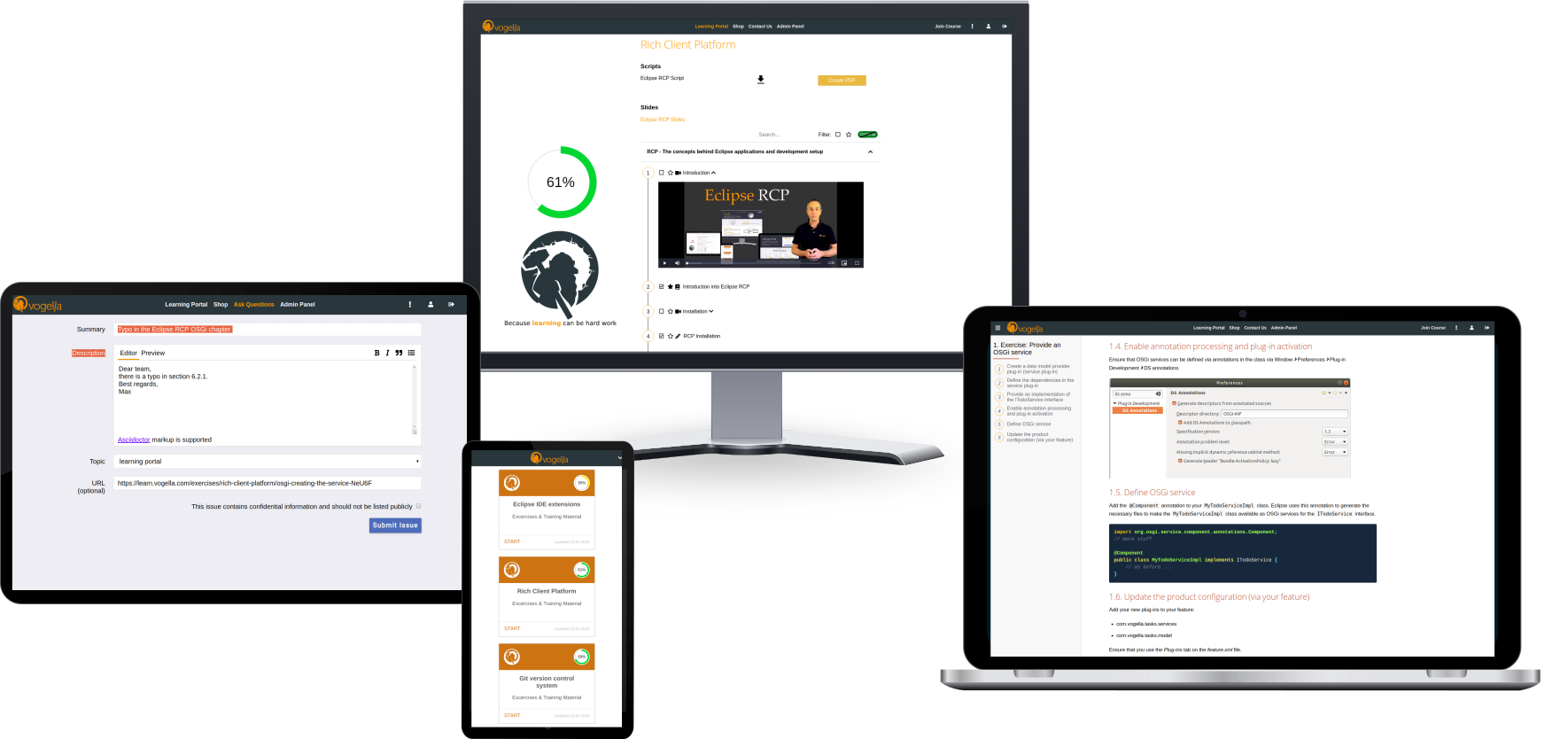Eclipse RCP
Purchase our premium content to receive access to extended RCP
content, explanation videos, and expert RCP topics. As a premium user, you can receive
support through our online support system.
Take advantage of this offering and learn all about Eclipse RCP.
- Topic: Rich Client Platform
- Language: English
- Fee first year: €500.00 excl. VAT
- Each following year: €120.00 excl. VAT
-
Content:
-
Features:
- >600 pages of script
- 27 instructional videos
- 144 hands-on exercises
- continuous updates
- one year access
- reduced price all following years
Why premium content?
Overview
- Watch explanation and coding videos recorded by our experts
- Read deep dive content and tutorials not listed at vogella.com
- Get access to comprehensive and coordinated exercises
- Report problems with the exercises and our experts will help you to solve them as soon as possible
- Learn to develop Eclipse RCP applications professionally while using the latest API's
- Get access to an extensive script with more than 700 pages, which covers every aspect of Eclipse RCP programming
- Continuous updates of the training material are always available
- Strengthen and deepen your knowledge through the development of a comprehensive training example
- Take advantage of the vogella GmbH company knowledge which is actively develops the Eclipse framework
- Compared to the vogella.com tutorials the training is guided, you find more material, you get access to videos and quizzes, you can receive a certificate and you can ask questions regarding the material to the vogella employees

Which topics are covered?
Agenda
Introduction to Eclipse and Eclipse 4
- Components of the Eclipse platform
- Eclipse 3.x in comparison with Eclipse 4.x
- Eclipse license
- Internet information sources
Eclipse architecture
- Software components
- Configuration files (plugin.xml, MANIFEST.MF)
- Extensions and extension points
- Important user interface components
Deployment of an Eclipse product
- Product configuration file
- Feature projects
- Branding and product export
- Run configuration
- Problem analysis during export
Eclipse 4 application model
- Application model and model components
- Model editor
- Naming schema for ID's
Dependency injection and annotations
- Overview dependency injection
- Dependency injection framework in Eclipse
- Field, method and constructor dependency injection
- Behavior annotations
- Application lifecycle annotations
Commands, Handlers, Menus and Toolbars
- Contributing to the menu and the toolbar
- Handling of popup menus
- Scope of handlers and core expressions
- Defining keybindings
Scope of injection
- IEclipseContext
- Injection search strategy
- Creation of injectable objects
- Model elements and dependency injection
Modularity of the Eclipse platform with OSGi
- Plug-ins and bundles
- Definition of dependencies between plug-ins
- Fragment projects
- OSGi framework start configuration and usage of the OSGi console
OSGi services
- Services and the OSGi service registry
- Publishing services via OSGi declarative services
- Usage of services in Eclipse 4
- OSGi declarative service definition with annotations
User interface development with SWT
- Overview Standard Widget Toolkit
- SWT event handling
- SWT layout manager: FillLayout, RowLayout and GridLayout
- User interface builder: SWT Designer
- Custom widgets and Nebula widgets
Introduction JFace
- Overview JFace components
- SWT resource management
- Control decorations for user feedback
- Introduction into the Viewer framework (LabelProvider, ContentProvider, ComboViewer)
- Handling Viewer selection
JFace TableViewer and TreeViewer
- ColumnLabelProvider and CellLabelProvider
- Editable tables
- Sorting, filtering, layouts and own label provider
Dialog and Wizards
- SWT standard dialogs
- JFace Dialogs
- JFace Wizards
Declarative styling with CSS
- Introduction into CSS
- Definition of styles and themes, colors and gradients
- Styling specific widgets
- Dynamic style switching at runtime
- Using the CSS Spy tooling
Platform services and interaction of components
- Service overview
- Part service
- Model service
- Selection service
- Command and Handler service
Editor handling in Eclipse 4
- Comparison Views and Editors
- Getting parts which behave as editors
- Using services to interact with parts
Accessing and extending the Eclipse context
- Accessing the context
- Extending the Eclipse context with own objects
- Using dependency injection to create own objects
Settings and preferences
- Configuration area and workspace
- Persistence of the Eclipse application
- Part persistence
- Dependency injection for preference values
Modularity for Eclipse 4 applications
- Contributing to the application model
- Static model contributions with fragments
- Dynamic model contributions with processors
Internationalization (i18n)
- Adding support for multiple languages
- Usage of fragment projects
- Outlook: translation services in Eclipse 4
Concurrent UIs
- SWT threading
- Avoiding invalid thread access
- Asynchronous processing with the Eclipse API
JFace Data Binding
- Introduction into databinding
- Observing properties
- Conversion, validation and update strategies
- Databinding for JFace Viewers
- Master / detail bindings
Target Platform
- Definition of development components
- Creation of target platform definitions
Migrating Eclipse 3.x applications
- Running Eclipse 3.x applications on top of Eclipse 4
- Mixing Eclipse 3.x and Eclipse 4.x components
- Discussion: Migration path for existing applications
Definition of own annotations for dependency injection
- Definition of new annotations
- Evaluation of new annotations
- Use cases
Creating and evaluating extension points
- Eclipse extensions and extension points
- Accessing existing extensions
- Creating and evaluating a new extension point
The Renderer framework
- Purpose of the Renderer framework
- Define your own renderer
- Outlook: Using an alternative renderer
- Outlook: Extending the application model
Building Eclipse applications with Maven
- High level overview of Tycho
- Building plug-ins, features, products and update sites
- Executing plug-in unit tests with Tycho